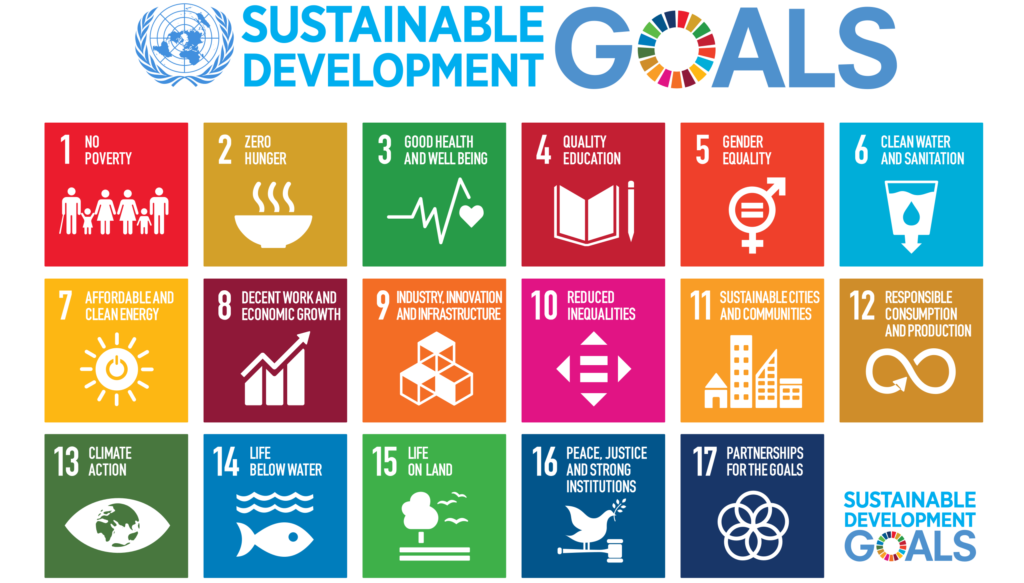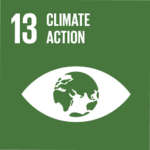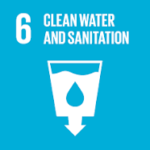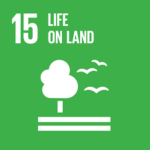The Sustainable Development Goals are the United Nations’ blueprint to achieve a better and more sustainable future for all. They address the global challenges we face, including poverty, inequality, climate change, environmental degradation, peace and justice.
Source: un.org
Based on the Sustainable Development Goals, we have identified the following focus areas for the development of our ESG Strategy.
1. Energy
The Climate Crisis is widely recognised as the most serious threat to the future well-being and existence of humans and other lifeforms on our planet.
With the 2030 Climate Target Plan, EU raises its ambition to reduce greenhouse gas emissions to at least 55% below 1990 levels by 2030, and to achieve climate neutrality by 2050. This cannot be successful without fundamentally changing the global community’s approach to consumption of energy. Sustainable energy consumption is two-fold:
- Clean energy sources
- Energy-efficient solutions
As part of our strategy to certify our portfolio according to the BREEAM In-Use “Very good” criteria, we are currently assessing measures to achieve both.
Clean Energy
In July 2021, we agreed terms with Delamode to expand the cross-docking facility on the outskirts of Vilnius with approx. 4,780 sqm.
In line with our common goal of sustainable operations, we agreed to install photovoltaic cells (solar energy) on the roof of the expanded area.
The expansion is scheduled for handover to the tenant in the summer of 2022.
Baltic Sea Properties is committed to solar as our preferred energy source in all new developments.
The world is making progress towards Goal 7 with encouraging signs that energy is becoming more sustainable and widely available. Access to electricity in poorer countries has begun to accelerate, energy efficiency continues to improve, and renewable energy is making impressive gains in the electricity sector.
Energy efficiency
By ensuring buildings are properly insulated and ventilated, while also making use of smart technology to monitor energy consumption, real estate owners can minimise the amount of energy a building needs to operate.
There’s a massive push for companies to comply with global sustainability commitments. Clean tech will play a big role, from providing insight into daily use of assets, to modelling demand cycles to lower consumption – and ultimately, to change how we source and use energy.”
— JLL
As part of our BREEAM In-Use assessment, we work with Vesta Consulting to identify which measures we can implement to improve energy efficiency for our buildings and how we can best make use of clean energy sources.
2. Health & Well-Being
The United Nations have defined Good Health & Well-Being as one of their seventeen Sustainable Development Goals.
Being a professional real estate investor and developer, we recognise our responsibility to provide healthy, safe and inclusive working environments for the employees of our clients, contracted builders, and the people within our own organisation.
Creating a healthy and safe workspace goes beyond avoiding risks of physical harm. We must also acknowledge the impact factors such as indoor air quality, daylight, visual comfort, acoustics, and temperature have on mental health and well-being.
As part of our BREEAM In-Use assessment, we work with Vesta Consulting to identify which measures we must take to live up to the standards we set for our company as a sustainable employer and real estate investor/developer.
3. Transport
Being a real estate owner and developer, largely invested within the logistics and transit segments, our clients’ transport of goods is at the core of what we do. The buildings within this segment is often situated in strategic locations along highways, where the people working in the facilities depend on cars to get to and from their workplace.
As a real estate developer, our operations also involve a lot of moving heavy materials to and from construction sites. We must acknowledge that our business segments historically have been heavily reliant on fossil-fuelled transport, and will need a fresh approach to become sustainable. Luckily, a lot can be done with solutions that are already available.
- Installation of charging stations for electric cars and trucks.
- Incentives for bicycling as transportation to/from the workplace, such as safe access roads, bicycle parking, showers, etc.
- Incentives for ride-sharing to/from the workplace.
- Lobbying for the development and expansion of bicycle roads/lanes and safe, accessible and affordable public transport.
The solutions to the issues in this category are likely closely linked with those of the categories “Energy” and “Health & Well-Being”.
As part of our BREEAM In-Use assessment, we work with Vesta Consulting to identify which measures we must take to best transform our corner of the industry and live up to the standards we set for our company as a sustainable employer and real estate investor/developer.
4. Water
Although the Baltics and Nordics still experience a lot of rain in a normal year, clean water is not an infinite resource. Drought crises have become an increasingly common issue in countries and cities across the globe, and water pollution from industry and agriculture is a problem everywhere.
As part of our BREEAM In-Use assessment, we work with Vesta Consulting to identify how we can improve water efficiency in the premises of our portfolio and our real estate development.
5. Food Waste & Recycling
According to the United Nations, the equivalent of almost three planets could be required to sustain current lifestyles by 2050, unless we change our practices to responsible consumption and production. Although awareness around these issues is a lot higher today than just a decade or two ago, there are still great inefficiencies in how we consume. For instance:
- Each year, an estimated one third of all food produced – equivalent to 1.3 billion tonnes worth around $1 trillion – ends up rotting in the bins of consumers and retailers, or spoiling due to poor transportation and harvesting practices.
- If people worldwide switched to energy efficient light bulbs the world would save US$120 billion annually.
Should the global population reach 9.6 billion by 2050, the equivalent of almost three planets could be required to provide the natural resources needed to sustain current lifestyles.
As a landlord, we need to recognise our own environmental impact in this regard, and look at how we can better facilitate for our clients to reduce waste and recycle more of the resources that go into their operations. Some such measures may be:
- Better recycling systems within the premises.
- Resale and recycling of materials, machinery, furniture, etc.
- Flexible design solutions to reduce waste associated with refurbishments and fit-out works.
- Temperature monitoring and efficient transit solutions for refrigerated and frozen goods.
- Smaller plates in cafeterias to reduce unnecessary food waste.
- Energy efficient lightening.
As a real estate developer, we must also take a responsible approach to which materials that go into our projects, as well as their longevity and environmental footprint throughout the building’s full life cycle. For instance, sand is the world’s most exploited resource after water, and we are consuming it faster than it can be replaced by geological processes which take hundreds of thousands of years. Our global consumption of sand for use in glass, concrete and construction materials has tripled over two decades to reach 50 billion tonnes a year, or about 17 kg per person each day (Reuters, 27 April 2022).
As part of our BREEAM In-Use assessment, we work with Vesta Consulting to identify how we can both reduce waste and replace the resources that go into our operations with more sustainable alternatives.
6. Resilience
Climate changes are already causing more extreme weather worldwide, and we need to adapt to ensure our buildings and infrastructures are resilient to dangers from these effects and safe for their users. Some of the ways changing weather patterns may affect us in the future are described below.
Flooding risk and surface water run-off
Both flooding rivers and extreme rainfall may cause servere damage and security risks where infrastructure and waterways don’t have sufficient capacity to absorb or channel the water away from buildings, roads and people. Uncontrolled water flows may also cause polluted rivers, water reserves, and green areas.
Nevertheless, by planning ahead businesses and communities may utilise rainwater to their benefit, for instance by sourcing it into irrigation systems and reserves for agriculture, golf courses, flower beds, and other water-intensive activities rather than using clean drinking water from the grid.
Natural hazards
Other natural hazards — such as wildfires, droughts, and heatwaves — are also occurring more frequently. Although the Baltics and Nordics are not among the regions associated with the highest risk, high temperatures are predicted to also affect us in the coming decades. Hopefully, the 2021 heatwave in Canada is no precursor, but we should still remain conscious of nature’s unpredictable forces.
Durability
With more extreme weather also comes other types of impact, dilapidation, wear and tear to our buildings and infrastructure than what we have traditionally built for in our region. To avoid unnecessary material use and waste generation from repairs and maintenance, we must therefore keep the future climate in mind when designing and protecting our buildings and their surrounding areas.
Security
Natural hazards may become a risk to the users of a building, either directly in the form of events such as flooding or wildfire, or indirectly through their long-term impact on building structures. Additional security risks also involve crime, traffic, work hazards, fire, etc.
Feelings of safety and security are fundamental to a person’s well-being, so to ensure that the building users both are and feel safe, landlords and developers should take a broad approach to a variety of security measures, such as:
- Monitoring and alarm systems.
- Access control.
- Fire safety.
- Escape routes.
- Water quality.
- Systems for drainage and irrigation.
- Building standards and durability.
- Production safety.
- Safety on access roads, pedestrian walkways and in parking lots.
As part of our BREEAM In-Use assessment, we work with Vesta Consulting to identify which measures we should implement to best ensure resilience in our operations and live up to the standards we set for our company as a responsible employer and real estate investor/developer.
7. Land-Use & Ecology
Almost 75 per cent of the earth’s surface has been altered by human activities, leaving less and less for wildlife and nature. One million animal and plant species are threatened with extinction, and as ecosystems are extremely complex, the ripple effects of losing any may have great consequences. One widely reported example is the declining bee population, which represents an enormous risk to future food production.
Despite having largely removed ourselves from nature, human existence is still heavily dependent on the ecosystems around us for everything from food and water to oxygen and weather patterns. Furthermore, green spaces have a proven positive effect on mental health.
We are at a breaking point and need to find a way to co-exist with nature, integrating it in the spaces we occupy rather than pushing it back. Some early steps in this direction may be:
- Measuring negative effects from new building projects on local wildlife and ecology.
- Transforming building roofs and surroundings into living green spaces.
- Installing of bee hives.
- Installing bee-friendly flower beds.
- Planting of trees.
- Improving systems for drainage and irrigation.
- Establishing sustainable practices for gardening of flower beds and other green areas.
- Donating to local initiatives to preserve nature and wildlife.
- Donating to preservation of rainforests and global wildlife protection.
- Establishing policies with sustainability requirements towards clients, contractors and other partners.
As part of our BREEAM In-Use assessment, we work with Vesta Consulting to identify which measures we must take to live up to the standards we set for our company as a sustainable real estate investor/developer.
8. Pollution
A wide variety of activities within the real estate industry may pollute local environments, air quality and the atmosphere in several ways, for instance by:
- Emissions, air pollution and noise from plant and machinery such as breakers, bulldozers, dumpers and excavators used on construction sites.
- Emission of HFCs and other greenhouse gasses from refrigerants used in building cooling systems.
- Gas emissions from building materials.
- Gas emissions and water run-offs from industrial production facilities.
- Gas emissions and run-offs from chemicals used in paints, glues, oils, thinners and plastics on construction sites.
- Air pollution, noise and run-offs from land clearing and demolition.
These factors may also have severe health implications for the people working in the buildings or on the constructions sites unless they are managed responsibly.
As part of our BREEAM In-Use assessment, we work with Vesta Consulting to identify which measures we must take to live up to the standards we set for our company as a sustainable employer and real estate investor/developer.








